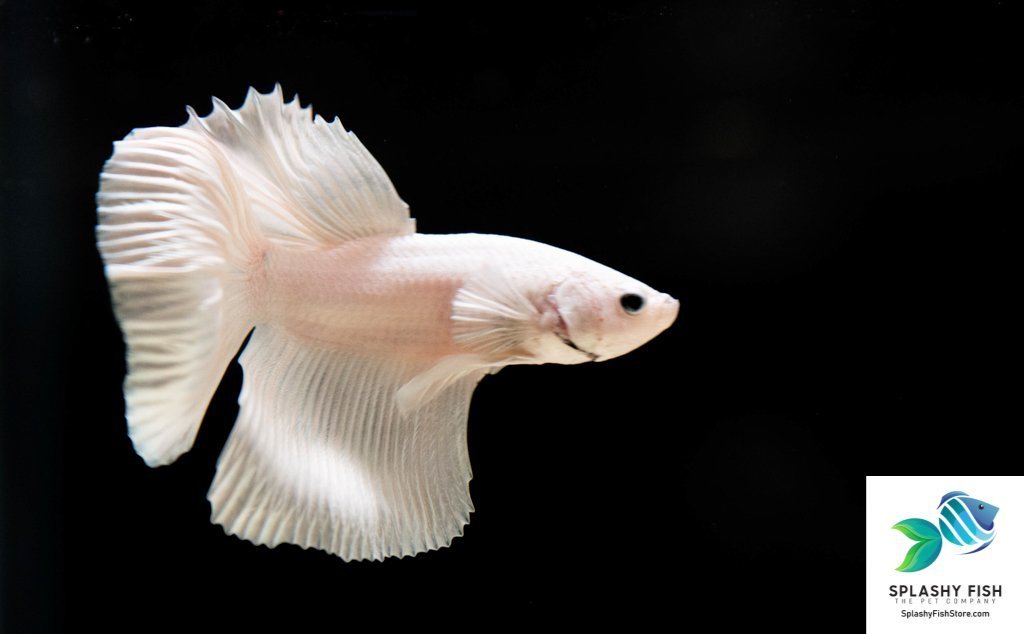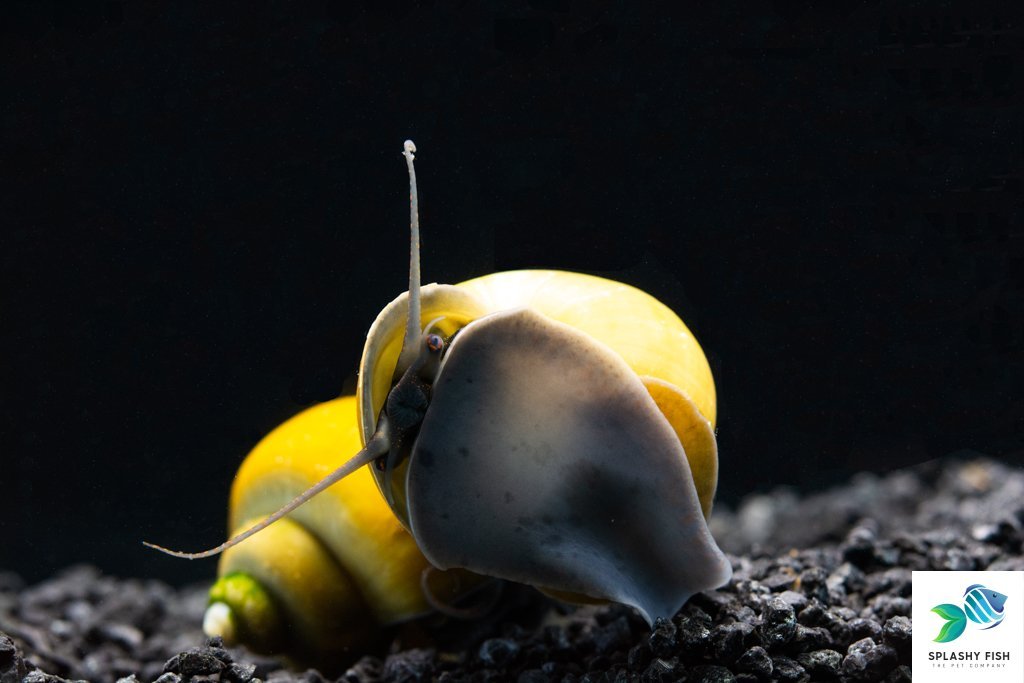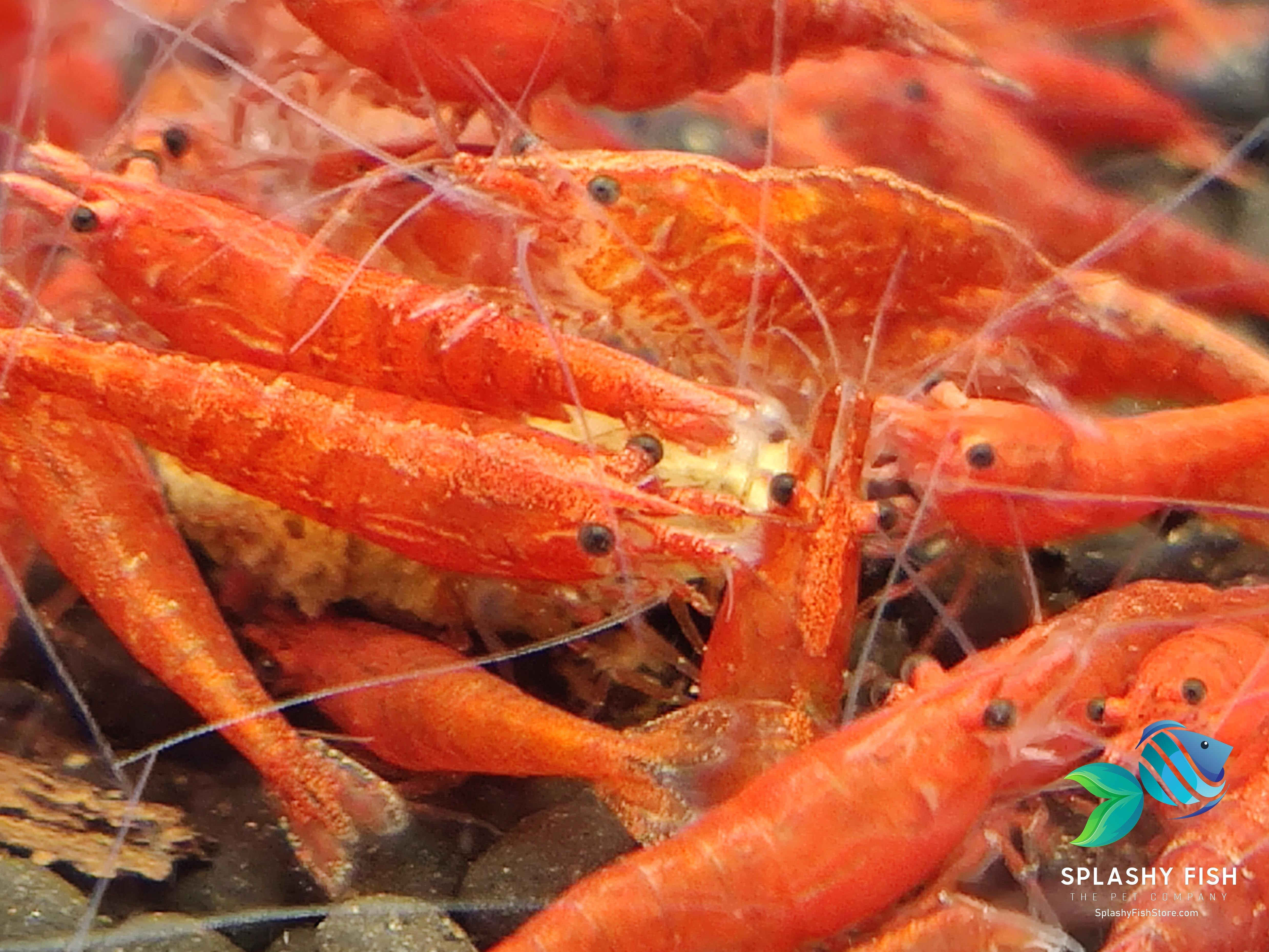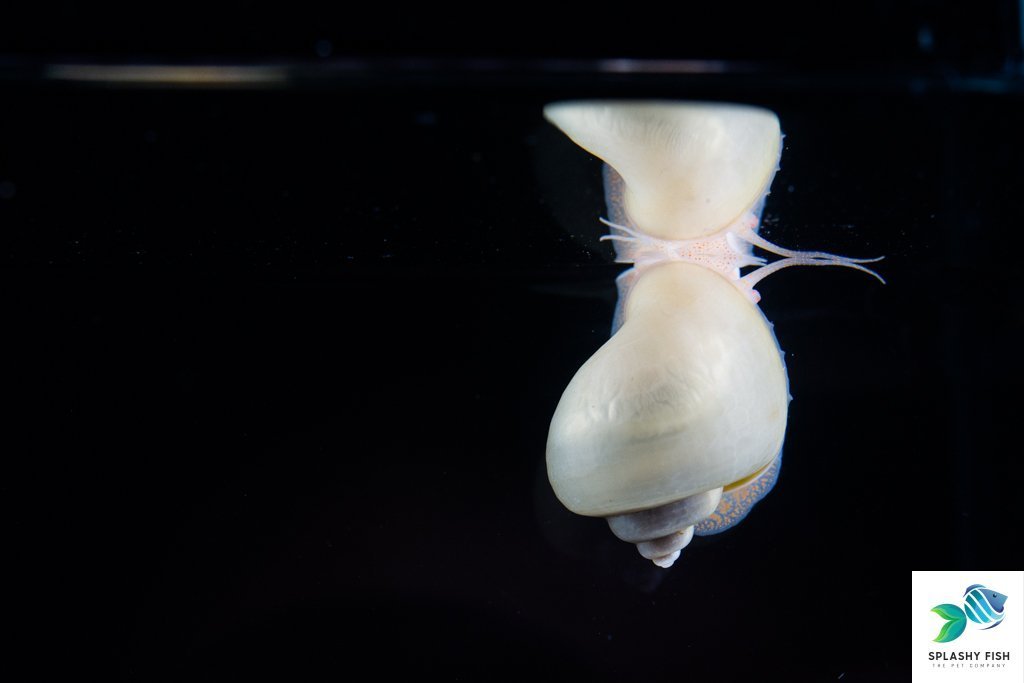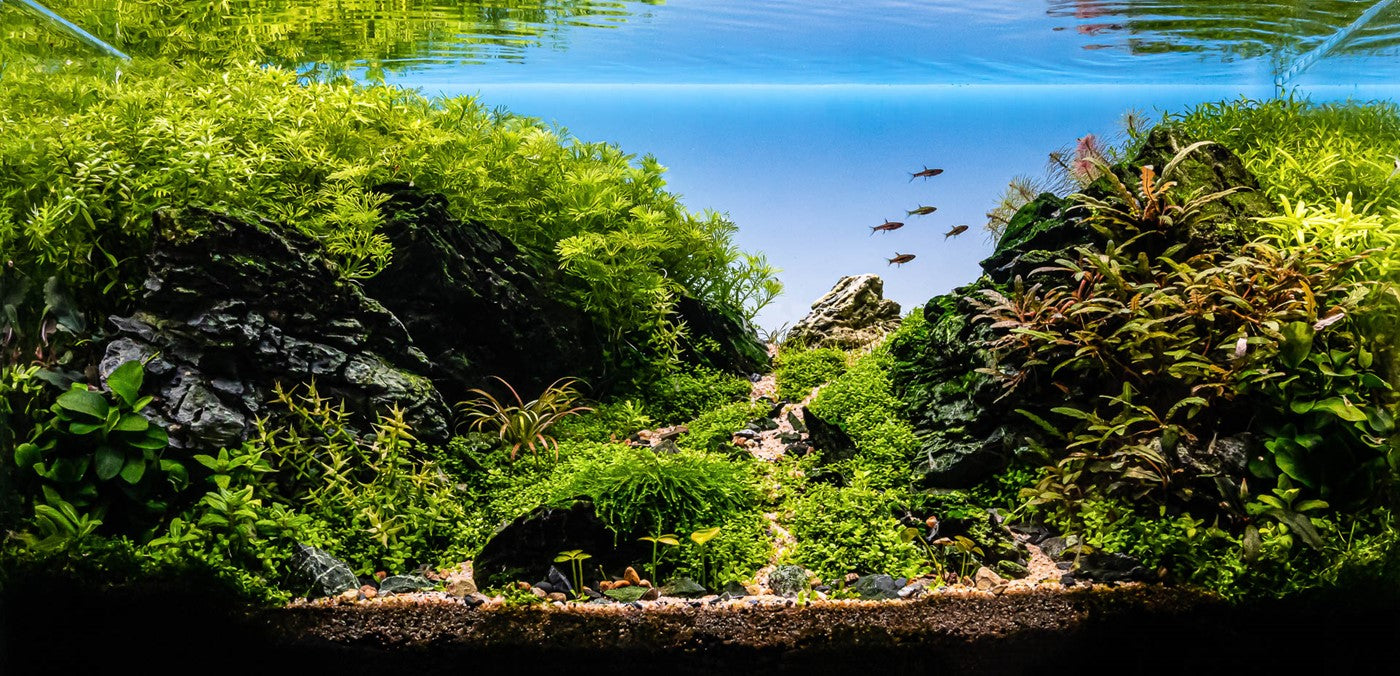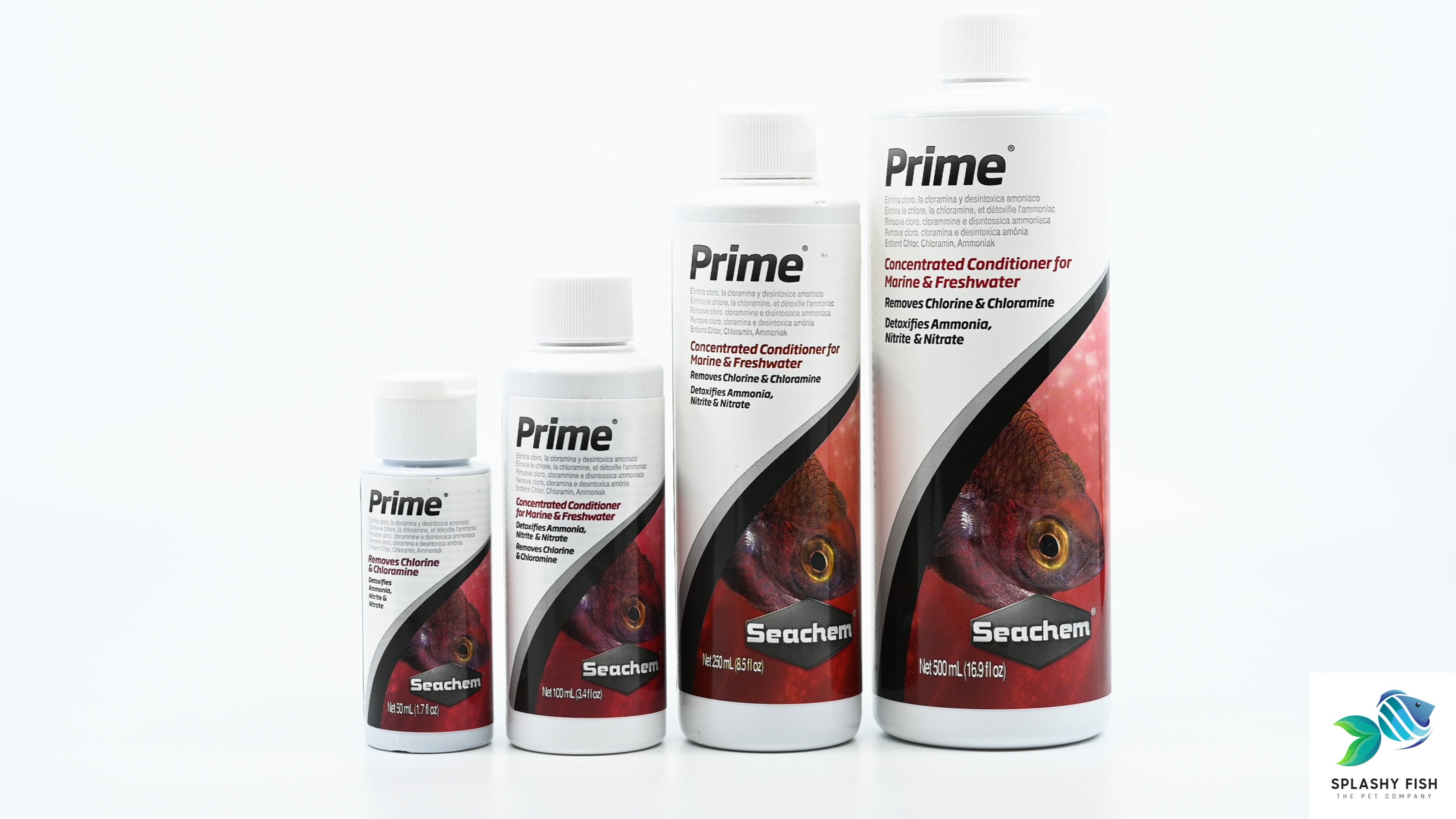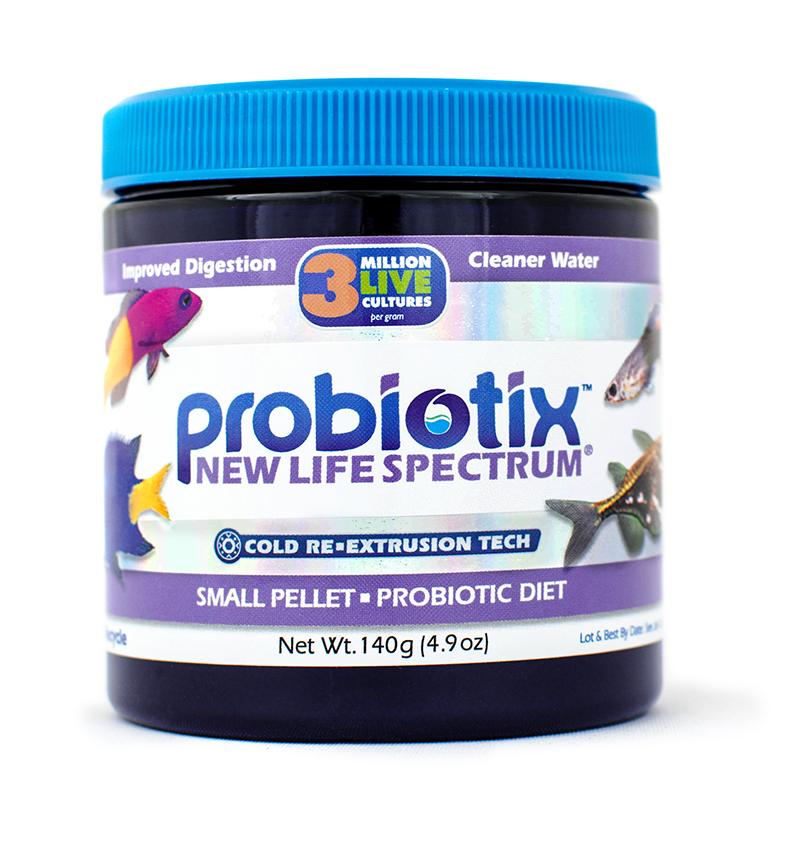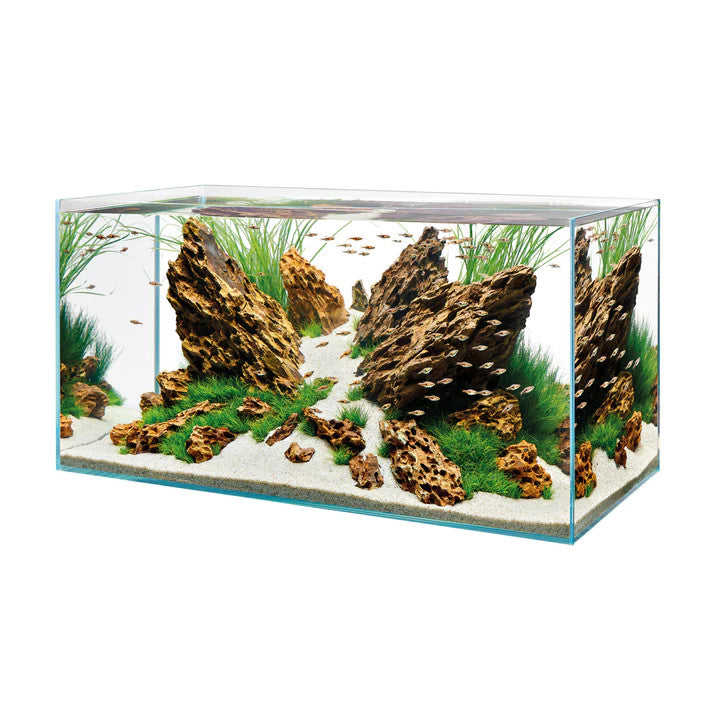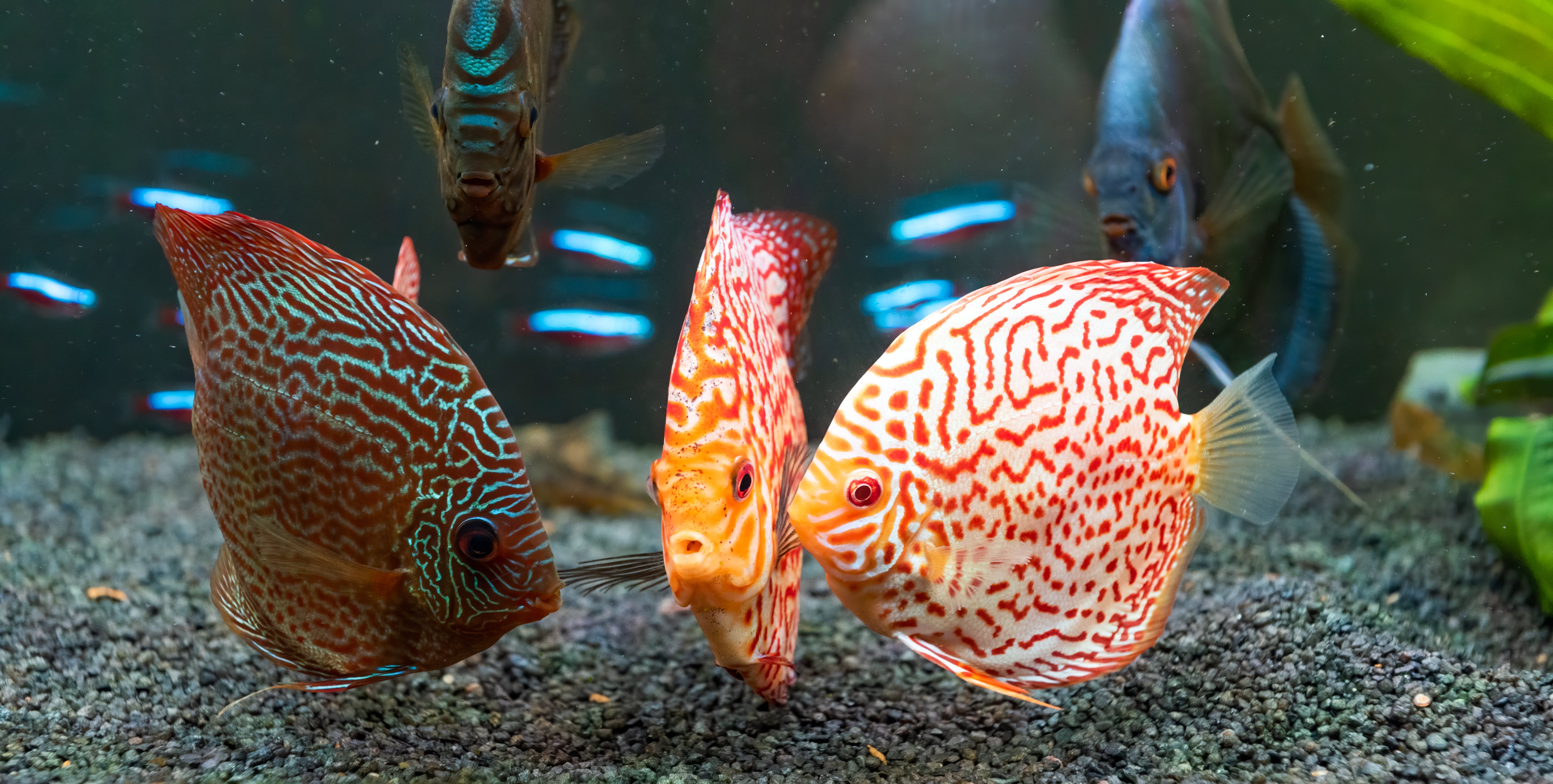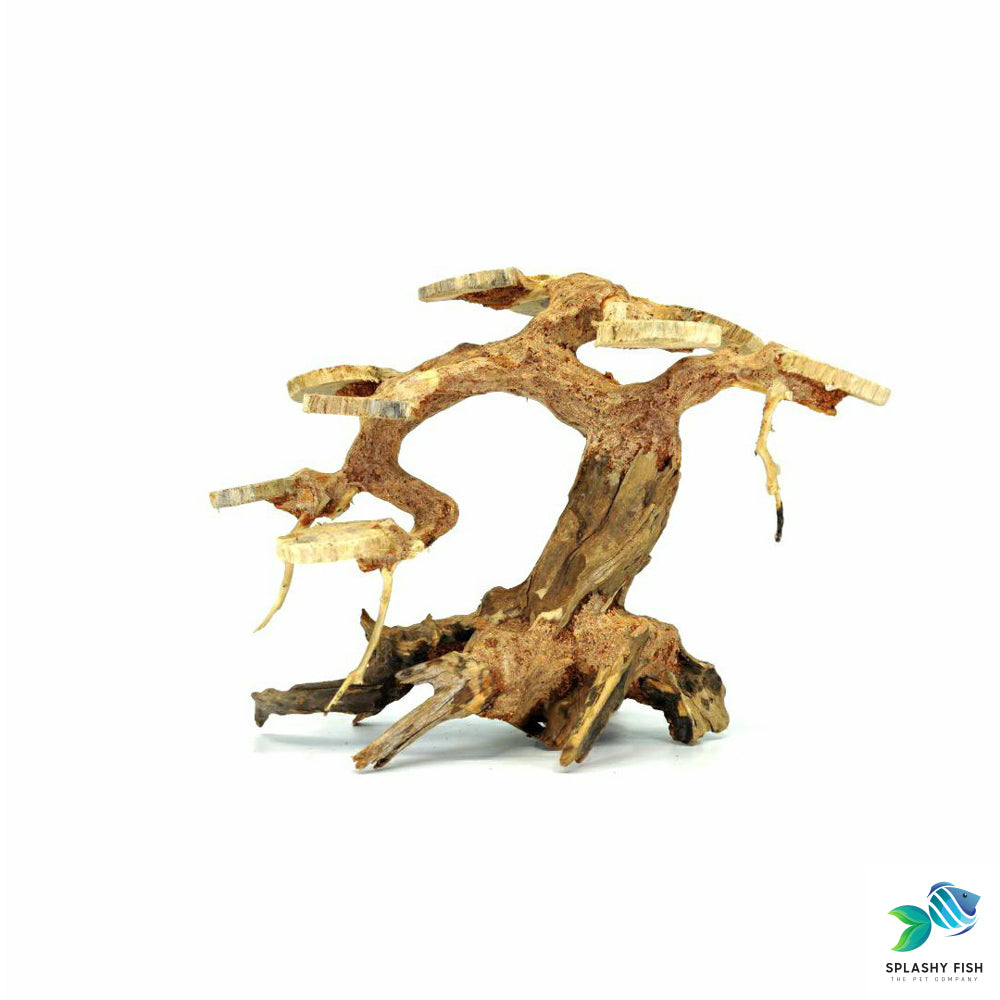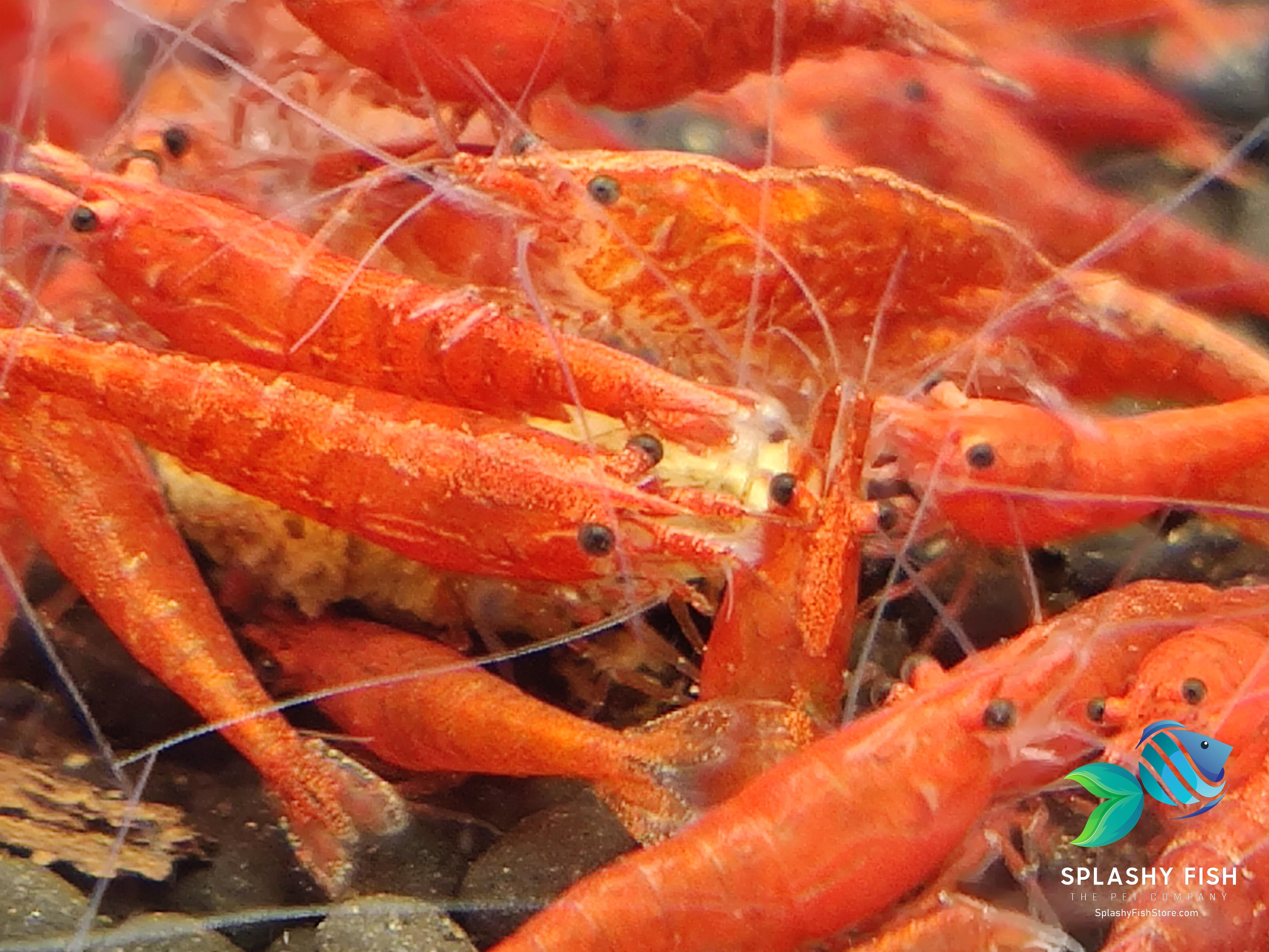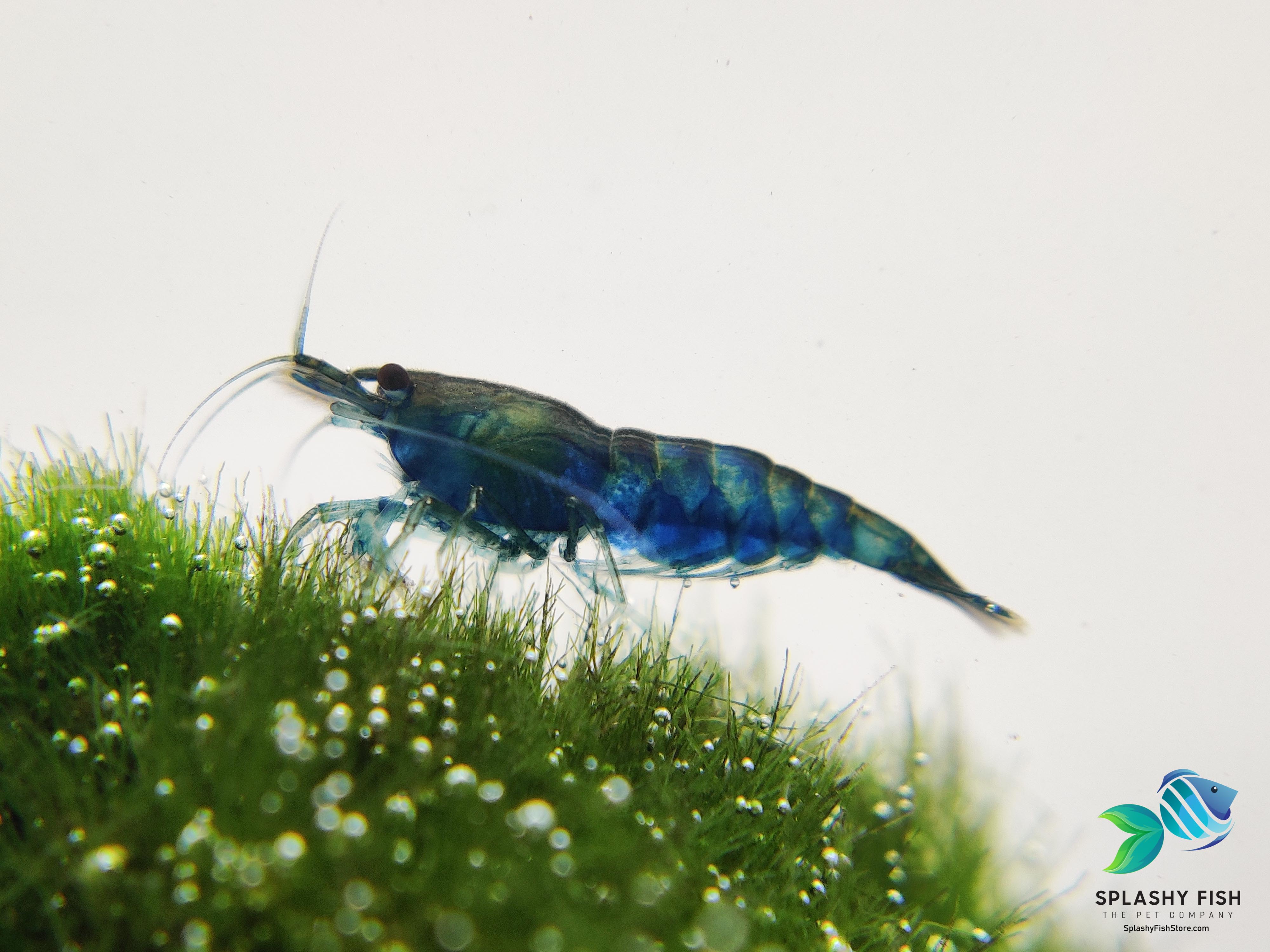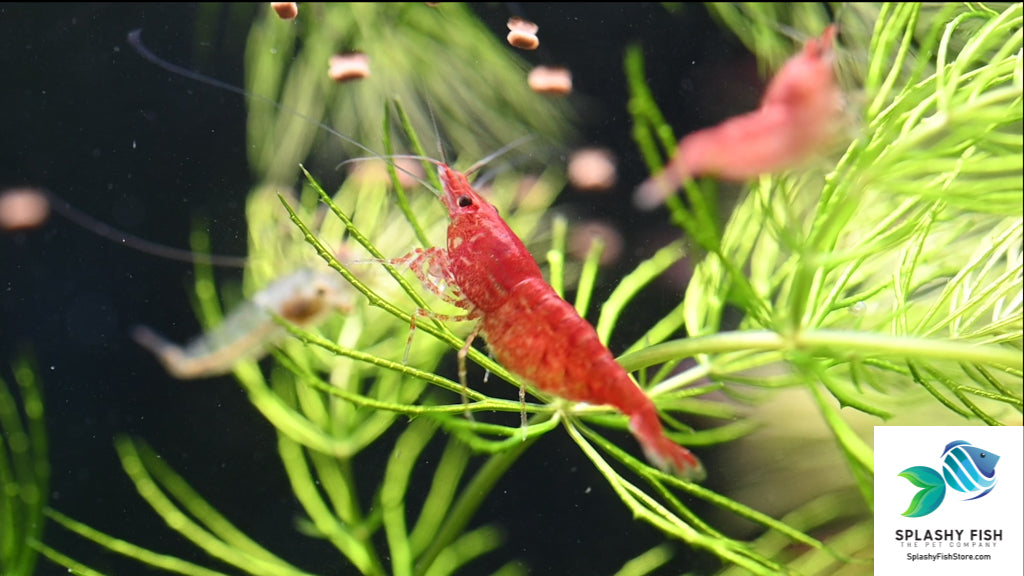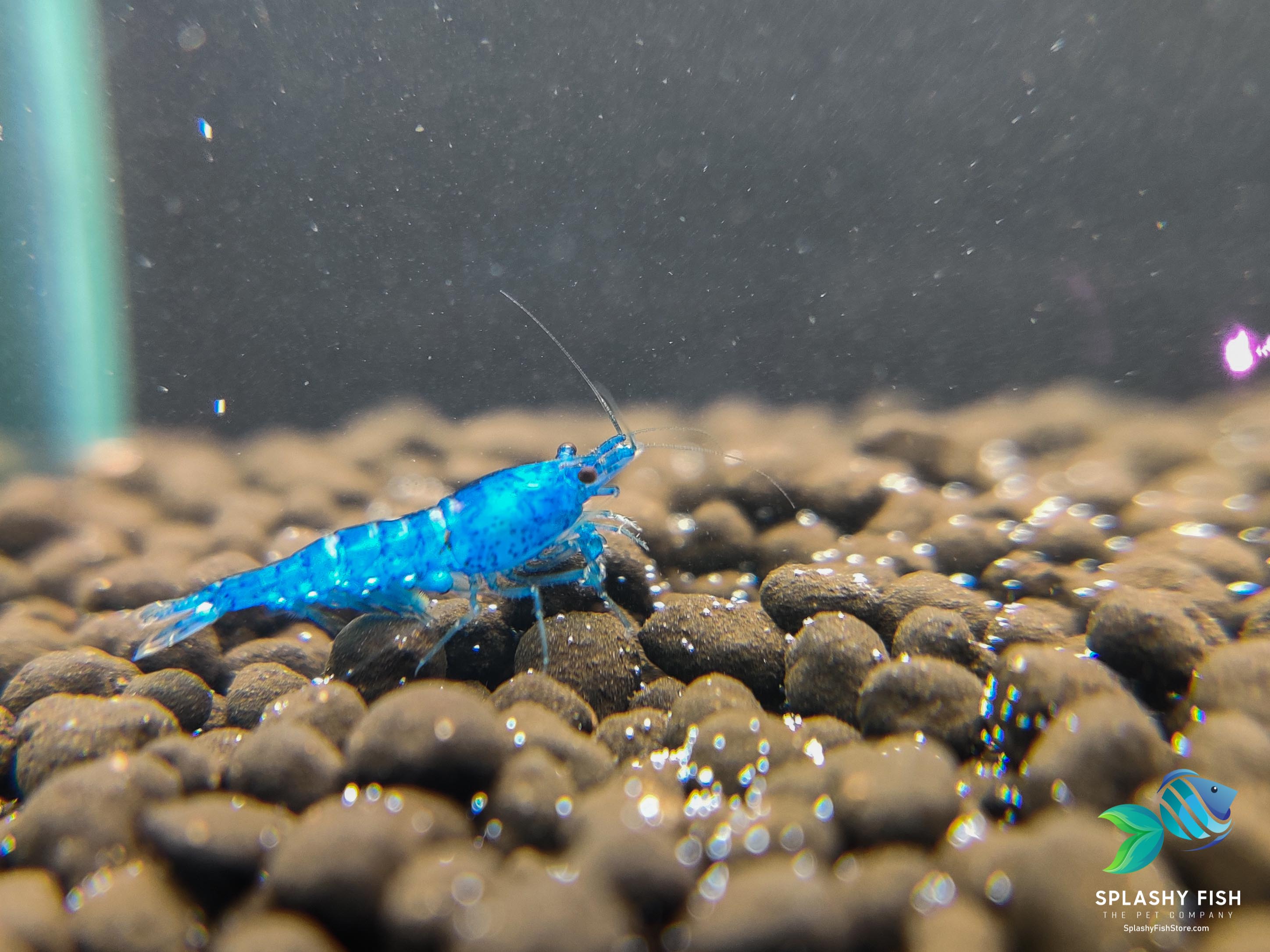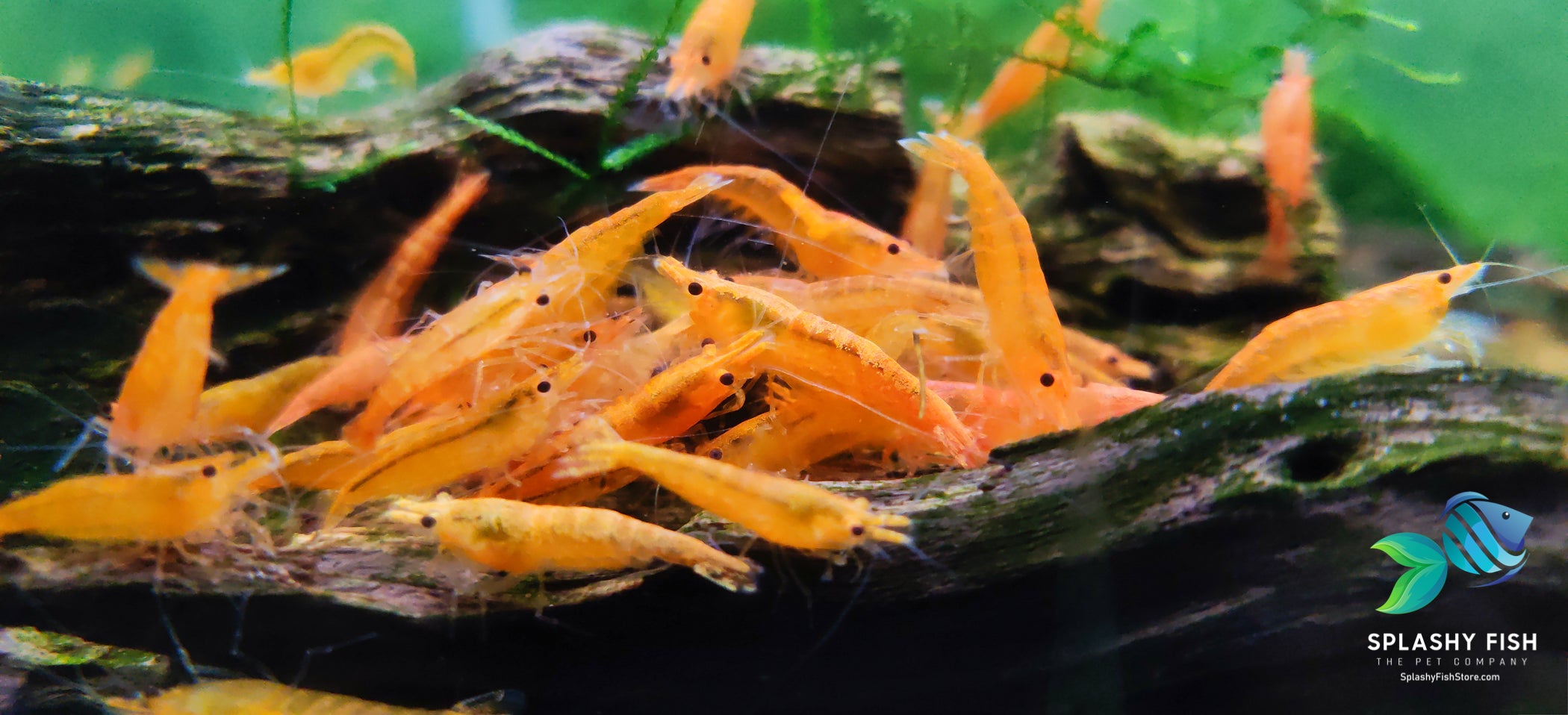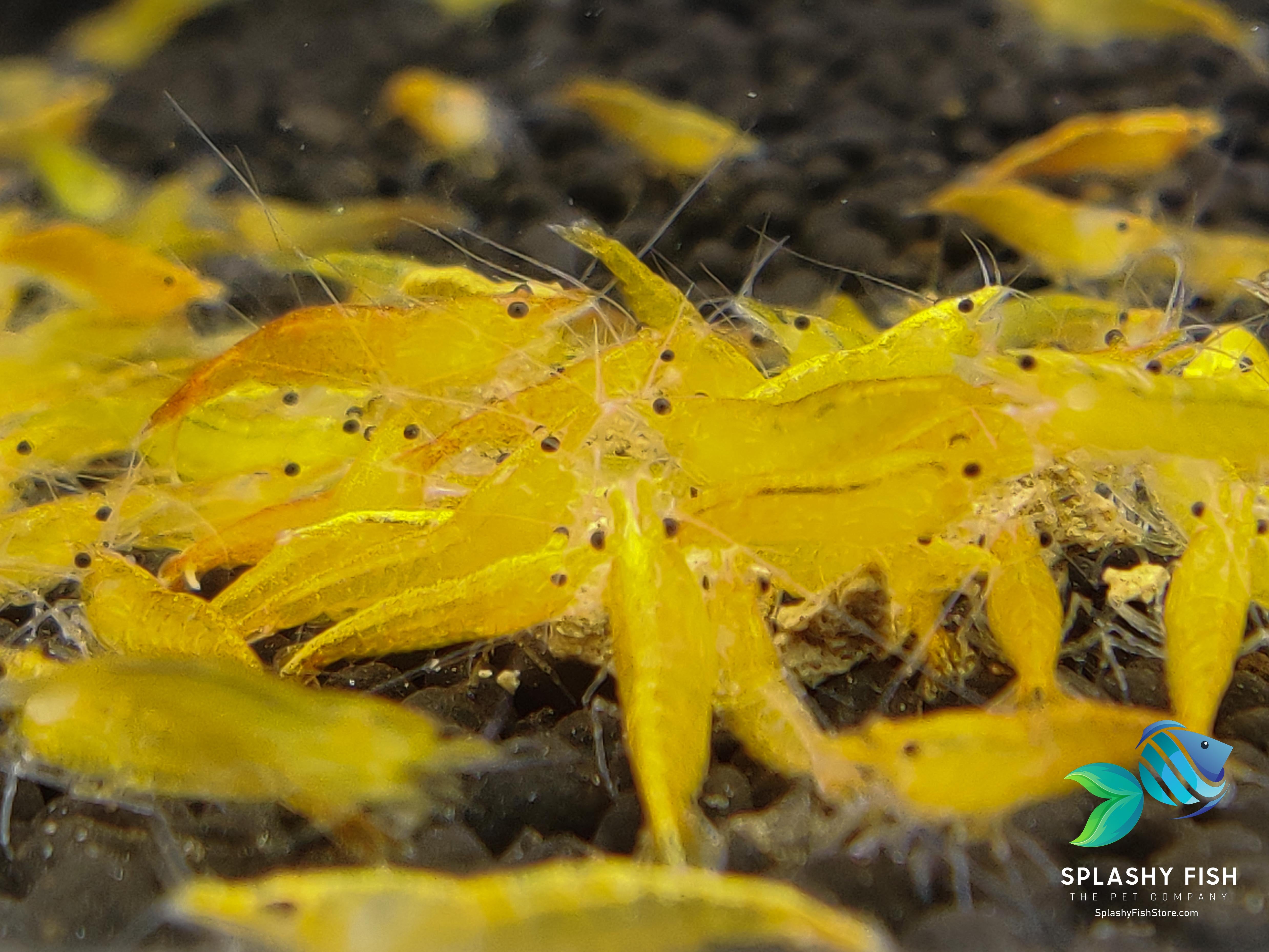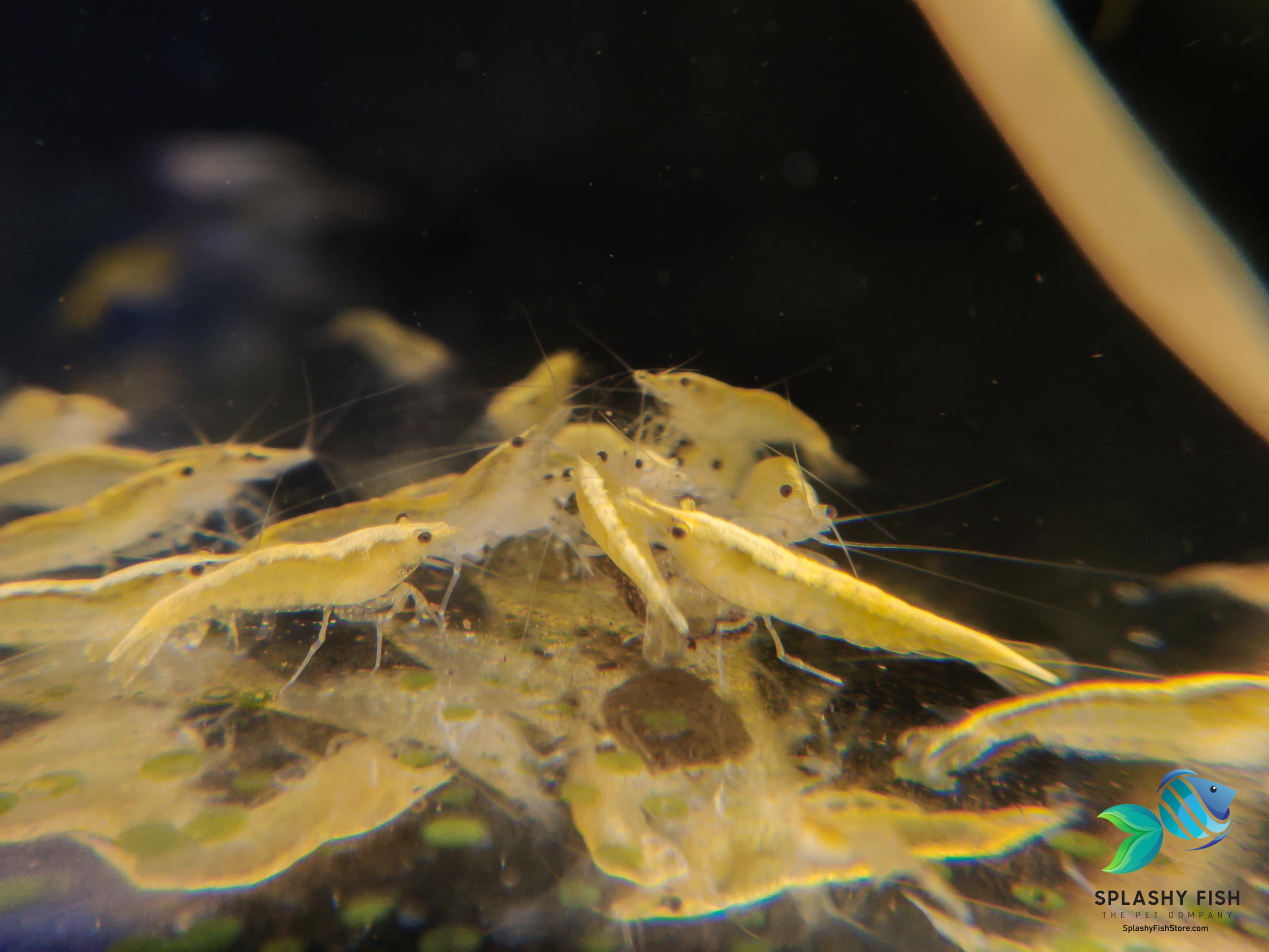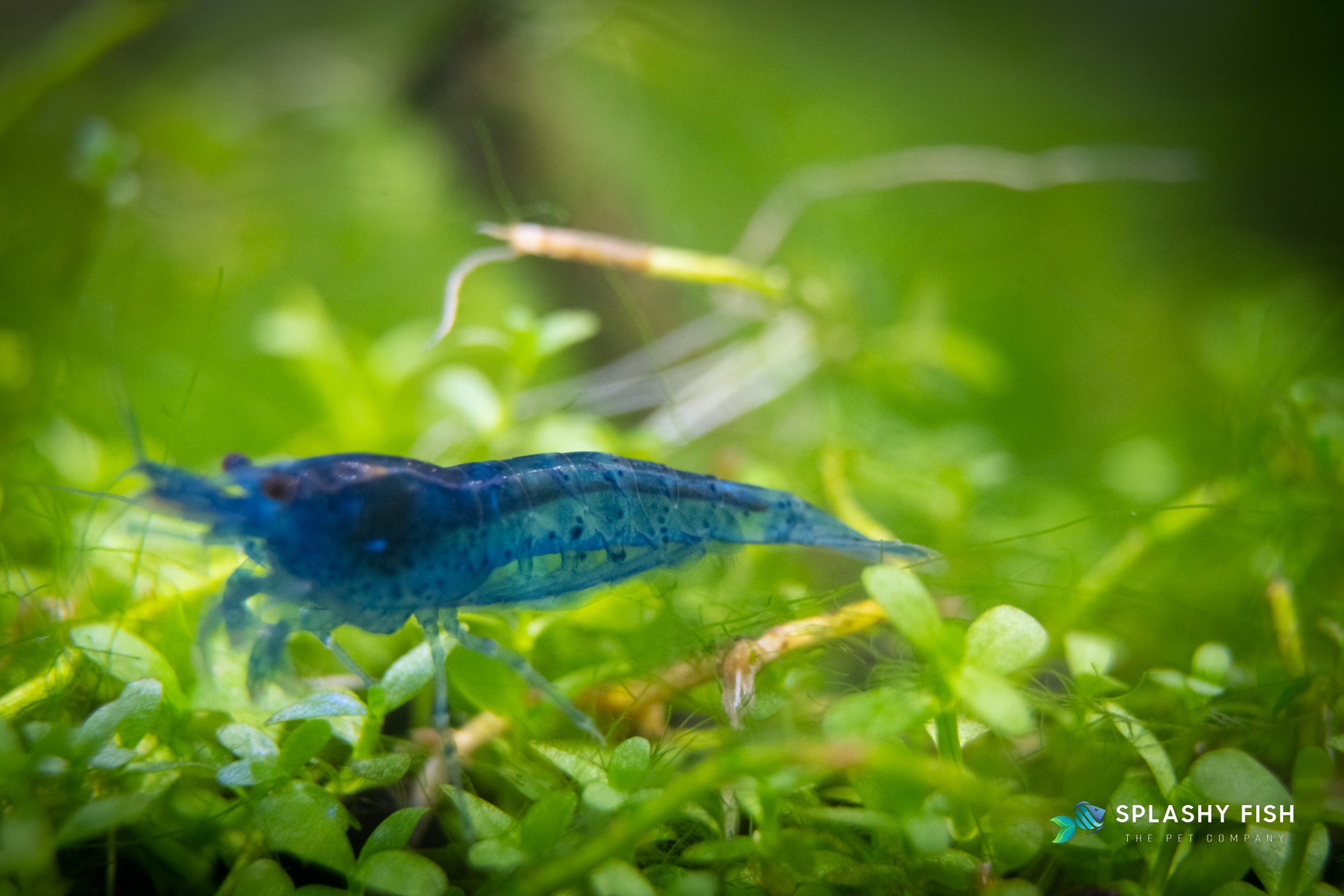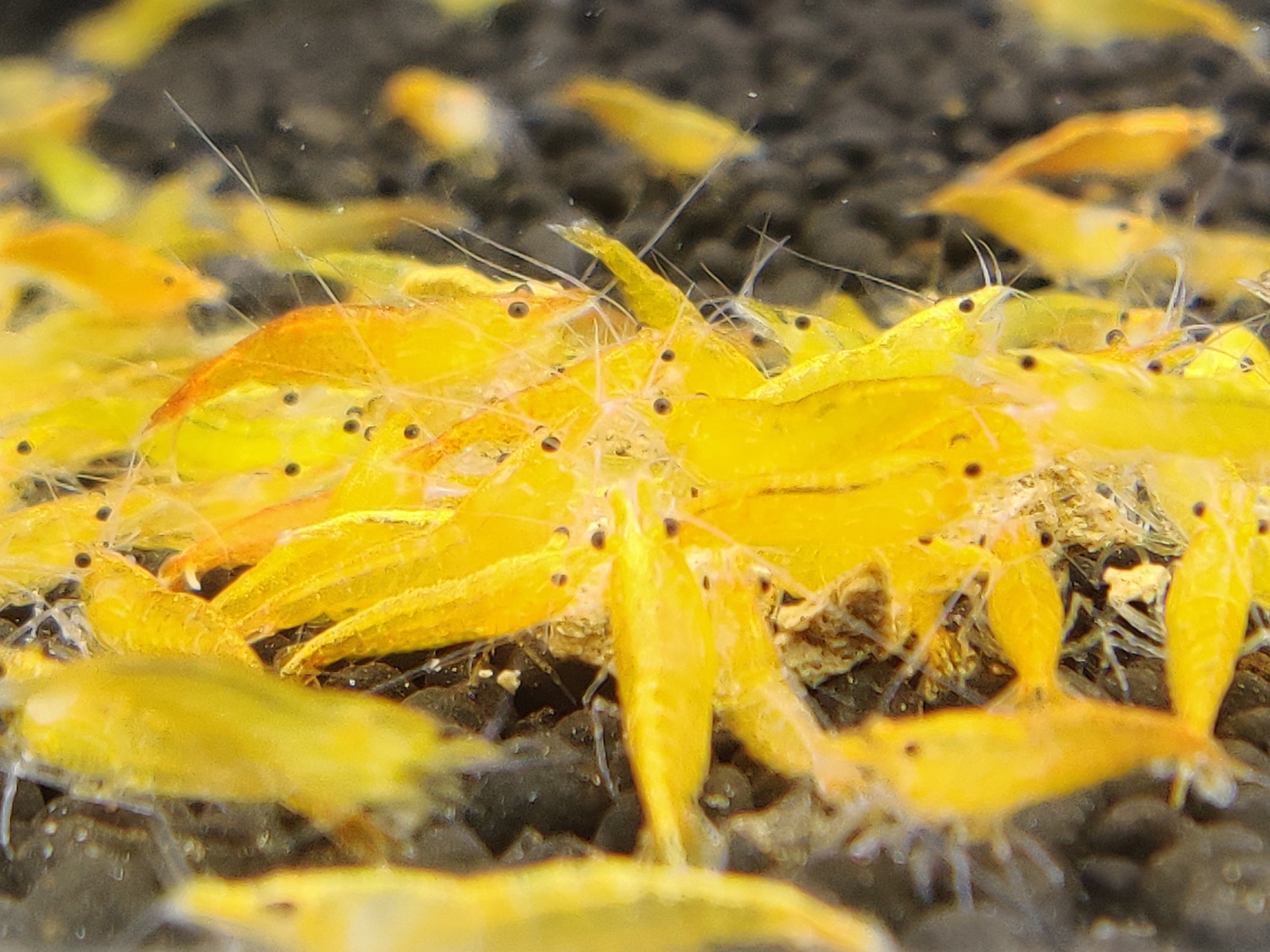
Neocaridina Shrimp
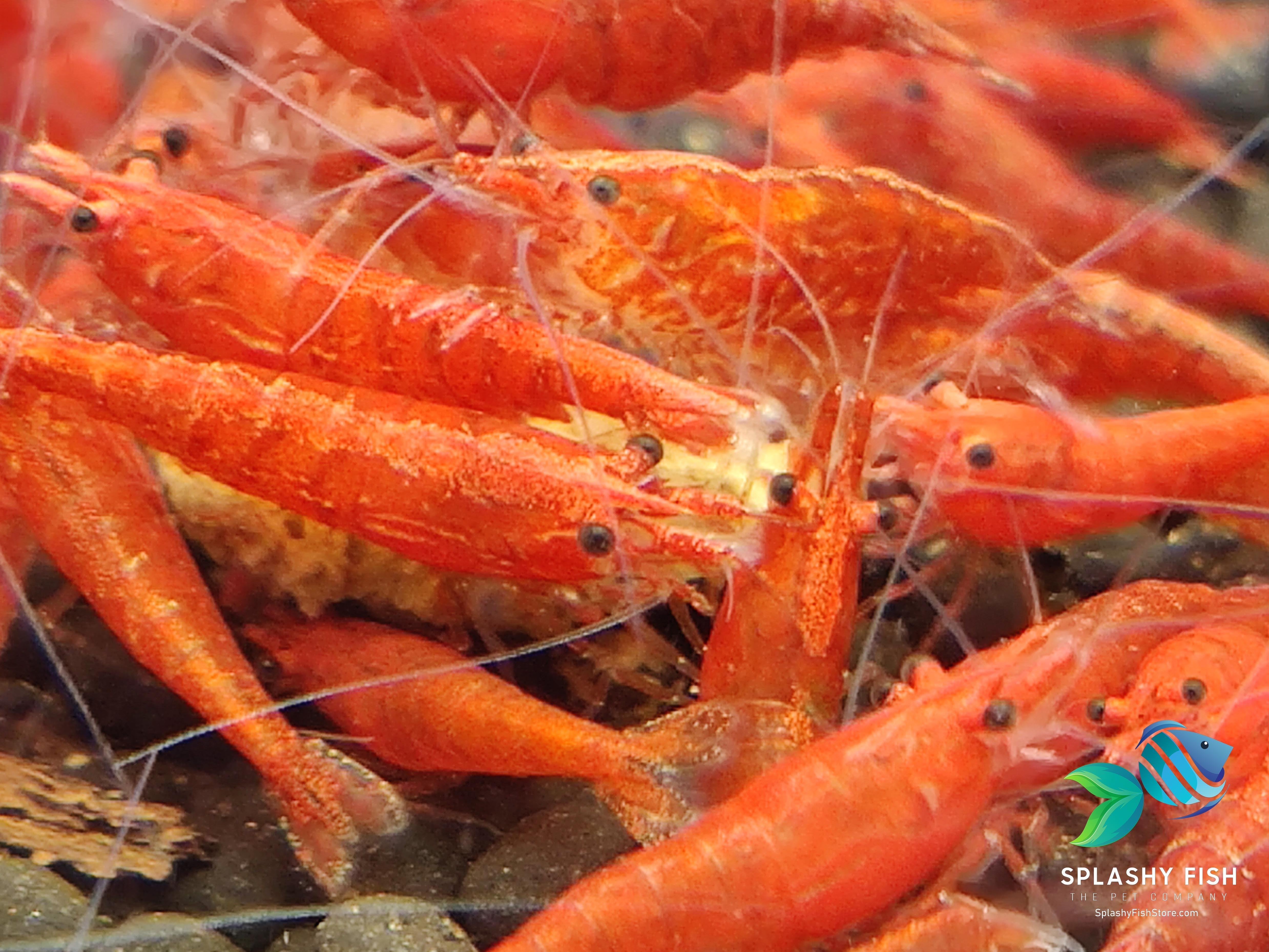
Neocaridina shrimp are a popular and colorful addition to many aquariums, adding a touch of vibrancy and interest to any aquatic setup. These small, hardy creatures are known for their bright colors and easy care requirements, making them a great choice for both beginner and experienced aquarists.
There are many different varieties of neocaridina shrimp to choose from, each with its own unique coloration and patterning. Some popular varieties include red cherry shrimp, yellow shrimp, and blue pearl shrimp.
In addition to adding visual appeal to your tank, neocaridina shrimp are also great at helping to keep your tank clean. These industrious invertebrates will happily munch on excess food and debris, helping to keep your tank looking its best.
When it comes to caring for your neocaridina shrimp, it's important to provide them with a suitable habitat that meets their needs. This includes a tank with plenty of hiding places, clean water, and a reliable source of food. Regular water changes and the use of a good quality filter will also help to ensure the health and well-being of your shrimp.
Overall, neocaridina shrimp are a fun and rewarding addition to any aquarium. With their vibrant colors and helpful cleaning habits, they are sure to be a hit with both novice and experienced aquarists alike.
Will Neocaridina shrimp interbreed?
Yes, Neocaridina shrimp species, such as Cherry Shrimp (Neocaridina davidi), can interbreed if different color variations are kept together. For example, if you have red cherry shrimp (often referred to as "Cherry Shrimp") and another color variation like blue or yellow Neocaridina shrimp in the same tank, they can crossbreed, resulting in offspring with mixed colors. This can lead to a variety of color patterns in the offspring.
To maintain the purity of specific color strains, it's essential to keep them separate from other Neocaridina shrimp colors. If you want to breed specific color variations, it's best to keep each color strain in its own tank to prevent interbreeding and maintain the desired color characteristics.
How long do Neocaridina shrimp live?
Neocaridina shrimp, such as Blue Dream (Neocaridina davidi), typically have a lifespan of around 1.5 to 2 years under optimal conditions in a well-maintained aquarium. However, with excellent care, some individuals may live slightly longer, up to 2.5 years or more. Factors such as water quality, diet, temperature stability, and the presence of predators can influence the lifespan of Neocaridina shrimp. Providing a suitable environment with proper water parameters and a balanced diet can help maximize their lifespan in captivity.
What do Neocaridina shrimp eat?
Neocaridina shrimp are omnivores, eating algae, biofilm, and detritus in the aquarium. They also enjoy commercial shrimp pellets, algae wafers, and blanched vegetables like zucchini, spinach. Occasionally, offer treats such as bloodworms or daphnia for variety and balanced nutrition. Avoid overfeeding to maintain water quality.
The Ultimate Guide to Keeping Neocaridina Shrimp: Everything You Need to Know
Welcome to the ultimate guide on how to keep Neocaridina Shrimp! If you're a shrimp enthusiast or considering adding these fascinating creatures to your aquarium, you've come to the right place. In this comprehensive guide, we'll walk you through everything you need to know about Neocaridina shrimp care. Whether you're a beginner or an experienced aquarist, this article will provide you with valuable information to ensure the happiness and health of your Neocaridina shrimp. We'll cover topics such as tank setup, water parameters, diet and feeding habits, breeding tips, common diseases, and more. From selecting the perfect tank to maintaining optimal water conditions, we'll share expert advice and tips to help you create a thriving environment for your Neocaridina shrimp. You'll learn how to provide the right food, create an ideal habitat, and promote successful breeding. Get ready to dive into the captivating world of Neocaridina shrimp and discover why these vibrant invertebrates are a popular choice among freshwater aquarium enthusiasts. Let's get started on your journey to becoming a successful Neocaridina shrimp keeper!
Description of Neocaridina Shrimp
Neocaridina shrimp are a popular choice for freshwater aquariums due to their vibrant colors, peaceful nature, and relatively easy care requirements. They are small, hardy shrimp that come in a wide variety of colors and patterns. Neocaridina shrimp are omnivores and will eat algae, biofilm, and shrimp food. They prefer acidic water with a pH between 6.0 and 7.0 and a temperature of 72-78°F.
Types and colors of Neocaridina shrimp Types and Colors of Neocaridina Shrimp
Let's dive into the world of Neocaridina shrimp—the colorful and fascinating tiny creatures that add charm to your aquarium. These shrimps come in various types and colors, making them a popular choice among aquarium enthusiasts. So, get ready to add a splash of vibrancy to your tank with these little showstoppers!
Solid Color Neocaridina Shrimp:
1.Red Cherry Shrimp Neocaridina Shrimp
Red Cherry Shrimp are beloved for their vibrant red coloration and ease of care. The red shrimp grade represents a solid foundation for a thriving colony, showcasing a pleasing cherry-red hue across most of their bodies. While some individuals may exhibit slight color variations or transparent patches, the overall visual impact remains attractive.
For those seeking the pinnacle of red coloration, the "Fire Red" and "Bloody Mary" grades beckon. Fire Red shrimp boast an intense, almost neon-red color that covers their entire bodies, creating a dazzling display in any aquarium. Bloody Mary shrimp, the rarest and most sought-after, elevate the intensity even further, with a deep, rich red that seems to glow from within.
2.Blue Dream Shrimp Neocaridina Shrimp
Blue Dream Shrimp stand as the crowning achievement in the world of blue shrimp breeding. Their coloration is an intense, almost iridescent blue that covers their entire bodies, creating a mesmerizing spectacle in any aquarium. This vivid hue is consistent and unwavering, making Blue Dream Shrimp the most sought-after and prized variety among blue shrimp enthusiasts.
While Blue Dream Shrimp reign supreme, other captivating blue shrimp varieties exist. Aura Blue Shrimp showcase a beautiful, softer blue with a subtle, almost hazy quality. This ethereal coloration adds a touch of mystique to any shrimp tank. Blue Velvet Shrimp, Sky Blue Shrimp known for their translucent bodies with a hint of blue, offer a delicate and unique aesthetic.
3. Yellow Shrimp Neocaridina Shrimp
Yellow Shrimp have multiple color, also known as Yellow Neon Shrimp, are a vibrant and cheerful addition to any freshwater aquarium. Their bright yellow coloration adds a burst of energy to the aquatic landscape, and their peaceful nature makes them suitable companions for a variety of other shrimp and fish species.
While Yellow Shrimp are a delight in their own right, the pinnacle of yellow coloration belongs to the Yellow Golden Back Shrimp. These stunning creatures boast an even more intense and saturated yellow hue, often with a beautiful golden sheen along their backs. Their vibrant appearance makes them a highly sought-after variety among shrimp enthusiasts.
4. Black Shrimp Neocaridina Shrimp
Black Shrimp is a Neocaridina shrimp, captivate with their deep, velvety black coloration. This striking hue creates a dramatic contrast against the lush greenery of an aquarium, making them a captivating addition to any aquascape. Their dark bodies often shimmer with subtle iridescent highlights, adding a touch of mystique to their appearance.
Within the realm of Black Shrimp, the Black Rose Shrimp variety stands out with an even more intense and saturated black coloration. Their deep, almost inky black hue evokes the velvety petals of a dark rose, lending an air of sophistication and elegance to their presence.
5. Orange Shrimp Neocaridina Shrimp
Orange Shrimp Neocaridina shrimp are a captivating variety of freshwater shrimp known for their vibrant orange coloration. These shrimp add a pop of color to any aquarium and are relatively easy to care for, making them a popular choice for shrimp enthusiasts.
There are two main types of Orange Shrimp Neocaridina shrimp: Orange Sunkist and Orange Pumpkin.
- Bright, intense orange coloration
- Consistent color throughout the body
- May have a slightly transparent or yellowish tinge on the abdomen
- Deep, rich orange coloration
- Often have a more opaque or "pumpkin-like" appearance
- May have a slightly reddish or brownish hue
Both Orange Sunkist shrimp and Orange Pumpkin shrimp are peaceful and social creatures that enjoy living in groups. They are also relatively hardy and can adapt to a wide range of water parameters. However, it is important to provide them with clean, well-oxygenated water and a varied diet to ensure their health and well-being.
Orange Shrimp Neocaridina shrimp are a beautiful and captivating addition to any freshwater aquarium. With their vibrant coloration and peaceful nature, they are sure to bring joy to any shrimp enthusiast.
Rili Neocaridina Shrimp:
1.Red Rili Shrimp Neocaridina Shrimp
Red Rili Shrimp, a captivating variety of Neocaridina shrimp, feature a striking pattern of alternating red and white bands along their bodies. These vibrant shrimp add a touch of elegance and charm to any freshwater aquarium. Their peaceful nature makes them ideal tankmates for other shrimp and small fish species. Red Rili Shrimp are relatively easy to care for, making them a great choice for both beginner and experienced shrimp keepers.
2. Blue Rili Shrimp Neocaridina Shrimp
Blue Rili shrimp Neocaridina shrimp are a captivating variety of freshwater shrimp known for their striking blue and white striped coloration. These shrimp add a unique and dynamic element to any aquarium and are relatively easy to care for, making them a popular choice for shrimp enthusiasts. Their vibrant patterns and peaceful nature make them a joy to observe, and they are sure to be a conversation starter in any aquatic setup.
3. Yellow Rili Shrimp Neocaridina Shrimp
Yellow Rili Shrimp Neocaridina shrimp are a vibrant and captivating variety of freshwater shrimp known for their distinctive yellow and white striped pattern. Their bright coloration adds a pop of color to any aquarium, and they are relatively easy to care for, making them a popular choice for shrimp enthusiasts. Yellow Rili Shrimp are peaceful and social creatures that enjoy living in groups. With their unique appearance and lively personality, they are sure to bring joy to any shrimp keeper.
4. Black Rili Shrimp Neocaridina Shrimp
Black Rili Shrimp, a mesmerizing variety of Neocaridina shrimp, captivate with their striking pattern of alternating black and white bands along their bodies. These elegant shrimp add a touch of sophistication and uniqueness to any freshwater aquarium. Known for their peaceful nature, Black Rili Shrimp make ideal tankmates for other shrimp and small fish species. While they require slightly more care and attention compared to some other Neocaridina varieties, their beauty and charm make them well worth the effort for dedicated shrimp enthusiasts.
5. Orange Rili Shrimp Neocaridina Shrimp
Orange Rili shrimp are a captivating variety of Neocaridina shrimp known for their vibrant orange coloration and striking pattern of alternating orange and white bands along their bodies. These shrimp add a touch of elegance and charm to any freshwater aquarium. Their peaceful nature makes them ideal tankmates for other shrimp and small fish species. Orange Rili shrimp are relatively easy to care for, making them a great choice for both beginner and experienced shrimp keepers.
Setting up the perfect Neocaridina shrimp tank
Neocaridina shrimp are a popular choice for freshwater aquariums due to their vibrant colors, peaceful nature, and relatively easy care requirements. To set up the perfect Neocaridina shrimp tank, follow these steps:
- Choose the right tank size. Neocaridina shrimp do not require a large tank, but a 10-gallon tank is a good starting point. This will provide enough space for a small group of shrimp to thrive.
- Use aquarium soil. Aquarium soil is an excellent choice for shrimp tanks because it can help to lower and maintain a low pH level in the water. Shrimp prefer acidic water with a pH between 6.0 and 7.0, and aquarium soil can help to buffer the pH level and prevent it from rising too high. Additionally, aquarium soil can help to provide shrimp with essential minerals and nutrients, and it can also help to create a more natural environment for them.
- Add plenty of aquatic plants. Aquarium Plants are essential for providing Neocaridina shrimp with hiding places and grazing areas. Choose plants with soft leaves or have a lot of surface area, such as Java moss or Amazon sword
- Provide a hiding place. Neocaridina shrimp are shy creatures and appreciate having places to hide. This can be anything from a piece of driftwood to a small cave.
- Use a sponge filter. Neocaridina shrimp are filter feeders and require a gentle water flow. A sponge filter is a good option because it will not harm the shrimp.
- Keep the water parameters stable. Neocaridina shrimp are sensitive to changes in water parameters. Aim for a pH of 6.5-7.5, a hardness of 5-15 dGH, and a temperature of 72-78°F.
- Feed your shrimp a variety of foods. Neocaridina shrimp are omnivores and will eat a variety of foods, including algae, biofilm, and shrimp food such as Kat Aquatics Shrimp Food or Shrimp Envy Food
- Monitor your shrimp regularly. Keep an eye on your shrimp for any signs of illness or distress. If you notice anything unusual, take action immediately.
By following these steps, you can create the perfect environment for your Neocaridina shrimp to thrive.
Water parameters and temperature for Neocaridina shrimp
Neocaridina shrimp are a genus of freshwater shrimp that are popular in the aquarium hobby. They are known for their vibrant coloration and relatively easy care requirements. Neocaridina shrimp are native to East Asia, but they have been introduced to other parts of the world through the aquarium trade.
There are many different varieties of Neocaridina shrimp, each with its own unique coloration. Some of the most popular varieties include Red Cherry Shrimp, Blue Dream Shrimp, and Yellow Golden Back Shrimp. Neocaridina shrimp are peaceful and social creatures that enjoy living in groups. They are also relatively hardy and can adapt to a wide range of water parameters. However, it is important to provide them with clean, well-oxygenated water and a varied diet to ensure their health and well-being.
Water Parameters and Temperature for Neocaridina Shrimp
The ideal water parameters for Neocaridina shrimp are as follows:
- pH: 6.0-7.5
- KH: 0-8 dKH
- GH: 5-15 dGH
- Temperature: 72-82°F (22-28°C)
It is important to note that Neocaridina shrimp are sensitive to changes in water parameters. Therefore, it is important to acclimate them slowly to any changes in water chemistry.
Neocaridina shrimp are a beautiful and captivating addition to any freshwater aquarium. With their vibrant coloration and peaceful nature, they are sure to bring joy to any shrimp enthusiast.
Feeding Neocaridina shrimp
What to Feed Neocaridina Shrimp
Neocaridina shrimp are omnivores and will eat a variety of foods, including:
- Algae
- Biofilm
- Shrimp food
- Blanched vegetables
- Freeze-dried foods
- Live foods, such as brine shrimp or daphnia
How to Feed Neocaridina Shrimp
- Feed your shrimp a small amount of food once a day.
- Avoid overfeeding, as this can lead to water quality problems.
- Offer a variety of foods to ensure your shrimp are getting a balanced diet.
- Place the food in a dish or on a leaf to prevent it from getting lost in the substrate.
- Remove any uneaten food after a few hours to prevent it from fouling the water.
Tips for Feeding Neocaridina Shrimp
- Feed your shrimp at the same time each day so they learn when to expect food.
- If you are going to be away for a few days, you can leave a small amount of food in the tank for your shrimp to eat.
- If you have a large number of shrimp, you may need to feed them more often.
Monitor your shrimp's eating habits to ensure they are getting enough food.
Breeding Neocaridina shrimp
Neocaridina shrimp are a popular choice for shrimp keepers due to their vibrant colors, peaceful nature, and relatively easy breeding requirements. To breed Neocaridina shrimp, follow these steps:
- Select a breeding group. Choose at least 7 to 9 male and 3 female shrimps that are both sexually mature. The female shrimp should have a large, round abdomen, while the male shrimp should have long, slender claws.
- Condition the breeding pair. Prior to breeding, condition the shrimp by feeding them a high-quality diet and ensuring that the water parameters are ideal. The water should be clean, well-oxygenated, and have a pH of 6.5-7.5, a hardness of 5-15 dGH, and a temperature of 72-78°F.
- Provide a breeding tank. The breeding tank should be at least 10 gallons in size and should be equipped with a sponge filter, heater, and plenty of hiding places. The substrate should be soft sand or aquarium soil, and the tank should be decorated with live plants.
- Introduce the breeding pair to the tank. Once the breeding tank is set up, introduce the breeding pair to the tank. The shrimp will initially be shy and may hide for a few days.
- Monitor the shrimp for signs of breeding. After a few weeks, the female shrimp will begin to show signs of breeding. Her abdomen will become even larger and rounder, and she may start to carry eggs.
- Care for the eggs. Once the female shrimp has laid her eggs, she will carry them attached to her swimmerets for several weeks typically for at least 30 days. During this time, it is important to keep the water parameters stable and to provide the shrimp with a high-quality diet.
- Hatch the eggs. After several weeks, the eggs will hatch and the shrimp larvae will be released into the water column. The shrimp larvae will feed on microorganisms in the water and will eventually grow into adult shrimp.
- Raise the shrimp fry. Once the shrimp fry are large enough to feed on their own, you can begin to feed them a variety of foods, such as algae wafers, shrimp food, and brine shrimp. The shrimp fry will grow quickly and will be ready to breed in a few months.
Common Health Issues and How to Care for Neocaridina Shrimp
Neocaridina shrimp are generally hardy and easy to care for, but they can be susceptible to a number of health issues. Some of the most common health issues include:
- Bacterial infections: Bacterial infections can be caused by a variety of factors, such as poor water quality, overcrowding, and stress. Symptoms of a bacterial infection include lethargy, loss of appetite, and discoloration of the body. Treatment for bacterial infections typically involves antibiotics.
- Fungal infections: Fungal infections can be caused by a variety of factors, such as poor water quality, overcrowding, and stress. Symptoms of a fungal infection include white or fuzzy growth on the body, lethargy, and loss of appetite. Treatment for fungal infections typically involves antifungal medications.
- Parasitic infections: Parasitic infections can be caused by a variety of organisms, such as worms and protozoa. Symptoms of a parasitic infection include lethargy, loss of appetite, and weight loss. Treatment for parasitic infections typically involves antiparasitic medications.
- Nutritional deficiencies: Nutritional deficiencies can occur if shrimp are not fed a balanced diet. Symptoms of a nutritional deficiency include lethargy, loss of appetite, and stunted growth. Treatment for nutritional deficiencies typically involves feeding a more nutritious diet.
- Stress: Stress can be caused by a variety of factors, such as poor water quality, overcrowding, and changes in the environment. Symptoms of stress include lethargy, loss of appetite, and hiding. Treatment for stress typically involves improving the water quality, reducing overcrowding, and providing a more stable environment.
How to Care for Neocaridina Shrimp
To prevent health issues and keep your Neocaridina shrimp healthy, follow these tips:
- Provide your shrimp with a clean and well-oxygenated environment.
- Maintain the water parameters within the ideal range for Neocaridina shrimp.
- Feed your shrimp a varied diet of high-quality foods.
- Avoid overcrowding the tank.
- Provide your shrimp with hiding places and plants to explore.
- Monitor your shrimp regularly for any signs of illness or distress.
Tank mates for Neocaridina shrimp
1. Tetra Fish:
- Ember Tetra: A small, schooling fish known for its vibrant red-orange coloration. Peaceful and easy to care for, making it a popular choice for community tanks.
- Cardinal Tetra: A strikingly beautiful schooling fish with a bright red body and iridescent blue stripes. Known for its active swimming behavior and peaceful nature.
- Neon Tetra: An iconic schooling fish with a vibrant neon blue stripe running along its body. Hardy and adaptable, making it suitable for a wide range of tank conditions.
2. Rasbora Fish:
- Harlequin Rasbora: A small, schooling fish with a distinctive diamond-shaped black spot on its body. Peaceful and active, it enjoys swimming in mid-water regions of the tank.
- Strawberry Rasbora: A petite, schooling fish with a vibrant red body and iridescent scales. Known for its peaceful nature and easygoing temperament.
- Galaxy Rasbora (Celestial Pearl Danio): A tiny, schooling fish with a mesmerizing celestial pattern on its body. Peaceful and shy, it prefers densely planted tanks with plenty of hiding spots.
- Chili Rasbora: A small, schooling fish with a fiery red body and a black horizontal stripe. Known for its active swimming behavior and peaceful nature.
- Emerald Eye Rasbora: A small, schooling fish with striking green eyes and a silvery body. Peaceful and easy to care for, making it a suitable choice for community tanks.
- Exclamation Point Rasbora: A small, schooling fish with a unique black spot resembling an exclamation mark on its body. Peaceful and active, it enjoys swimming in mid-water regions of the tank.
3. Madaka Rice Fish:
- Gold Madaka Japanese Ricefish: A madaka rice fish with a vibrant golden body and black stripes. Hardy and adaptable, it can tolerate a wide range of water conditions.
- Platinum Madaka Japanese Ricefish: A Japanese rice fish with a silvery-white body and black stripes. Known for its peaceful nature and easygoing temperament.
4. Amano Shrimp: A popular freshwater shrimp known for its algae-eating abilities. Hardy and adaptable, it is a valuable addition to any aquarium with algae problems.
5. Freshwater Snails:
- Mystery Snail: A large, colorful snail with a unique operculum that seals its shell when retracted. Peaceful and easy to care for, it is known for its voracious appetite for algae.
- Nerite Snail: A small, attractive snail with a distinctive spiral shell. Known for its algae-eating abilities and peaceful nature, it is a great addition to any aquarium.
- Ramshorn Snails: A small, prolific snail with a spiral shell that resembles a ram's horn. While they can reproduce quickly, they are generally peaceful and can help control algae growth in the tank.
Conclusion
In conclusion, Neocaridina shrimp are captivating additions to any aquarium, offering vibrant colors, peaceful coexistence, and a relatively low maintenance experience. Whether you're a seasoned shrimp keeper or just starting, these remarkable creatures provide an exciting and rewarding journey. By adhering to the advice in this guide, you can ensure your Neocaridina shrimp receive optimal care and flourish in their aquatic home.
Should you wish to embark on this captivating journey, Splashy Fish is your trusted source for a diverse selection of Neocaridina shrimp for sale. We are dedicated to providing healthy and vibrant specimens, making your aquarium a truly mesmerizing display.
Remember, prioritize the well-being of your shrimp, create a beautiful and natural environment, and with dedication, your Neocaridina shrimp colony will thrive, bringing you years of enjoyment.


